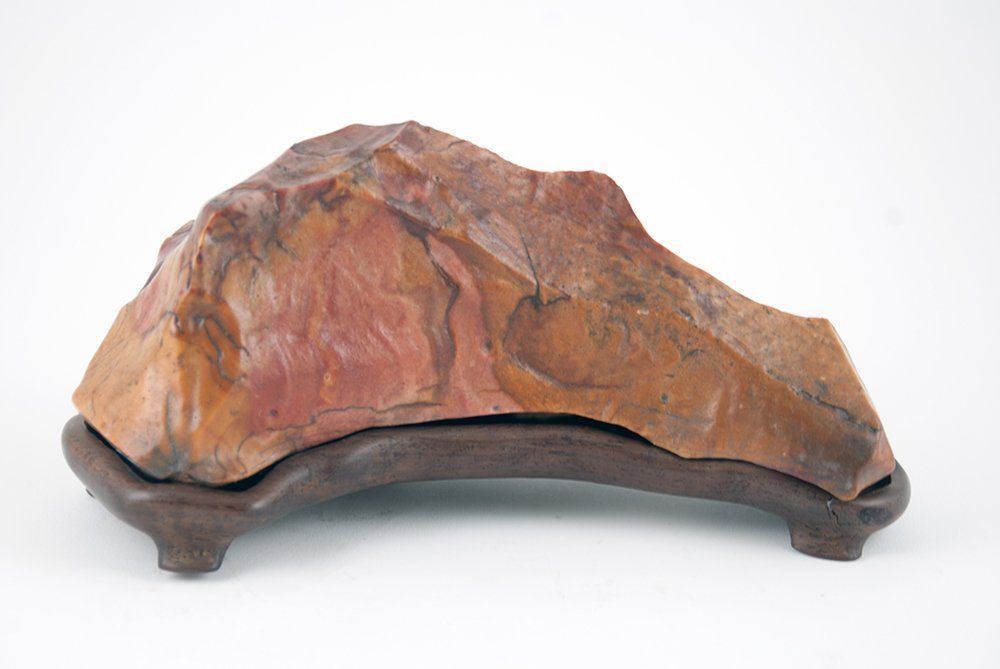The Stones of the Gobi Desert, Part 2Introduction to the Stones of the Extensive Gobi Desert
By Thomas S. Elias, December, 2013
Two names are commonly used in western literature when referring to viewing stones from this vast region. The first name is Gobi Desert Stones or Gebi shi in pinyin. The second is fengli meaning "wind-blown." Some western writers treat all stones from the Gobi as fengli, but this is a major error, as the two words are not synonymous. The Gobi Desert is a geographical area; the pinyin word fengli means “wind-blown”, a term used in China only for stones that are shaped by strong sand-laden winds over a long period of time. Fengli stones are often more angular and have sharp edges resulting from the direction of the prevailing winds, and the softer stone has gradually eroded away leaving the harder elements behind. They often have unusual and fascinating shapes.
Because most of the stones originating from the Gobi result from environmental factors other than wind alone, the term "Gobi Desert Stones" is the preferred way to refer to stones from this region of Asia.
- One example is the degradation of stone from the periods of annual freezing, thawing, and expansion that results from the extreme temperatures that exist in regions of the Gobi Desert.
- Other stones can result from a combination of factors, such as an initial degradation process, followed by exposure to strong sandy winds.
- Another type of stone comes from ancient or modern river beds. Water-tumbled agates and chalcedony stones can be found in these sites. Many rivers flow into the Gobi but disappear under the desert floor. Some may join underground and re-surface again. The Tarym river in the Taklan Makan basin is a good example. The Yellow River flows through the southern edge of the eastern Gobi Desert.
- Other stones are mined from mountain ranges. Some miners search for specific mineral-laden layers, while others search for pockets, cavities, and faults where certain minerals are formed underground. The grape agates are a good example of this.
Finally, petrified wood, shells, and bones are formed by a mineralization and replacement process, rather than by wind-blown processes. While some colorful Gobi Desert stones may have been collected in imperial China, the presence of these in Chinese stone appreciation dates to the early to mid-1990s.
This corresponds to the time of the rapid expansion of stone collecting in remote areas of China, far from the traditionally sources of stones utilized in Tang, Song, and later dynasties. The interest is desert stones grew quickly because of the beautiful patterns, colors, and composition. Most of the Gobi Desert stones are strongly silicaceous making them harder than the carbonate stones in southern China. Because of this, Gobi Desert stones are more difficult to modify. This lack of enhancement is seen by many Chinese stone collectors as adding to the attractiveness of Gobi Desert Stones.
The primary characteristics used to determine an excellent Gobi Desert stone are shape, color, surface pattern, and material. Stones that are figure shaped or those with patterns that resemble people, Buddha, animals or mythical creatures are highly valued. Other stones with shapes that resemble different foods, body parts such as ears, hands, and sex organs are also collected. One of the most famous of the figure stones is one that resembles an old woman's face. It has a value in excess of $1 million.
Grape agates are scarce and come from just one mine; thus, their production and supply are carefully controlled. As demand has exceeded the supply of these stones, prices have risen sharply. A grape agate feature that adds value is the size of the individual globular grape-like structures. Larger sized “grapes” are rarer and more expensive. Color adds value, especially multiple colors which are scarce. Some of the beautiful, multi-colored, large grape agates sold in China for $200,000 to $400,000 in 2013. As a result, Gobi Desert stones are some of the most sought after and most expensive stones in the entire stone appreciation economy in China.


